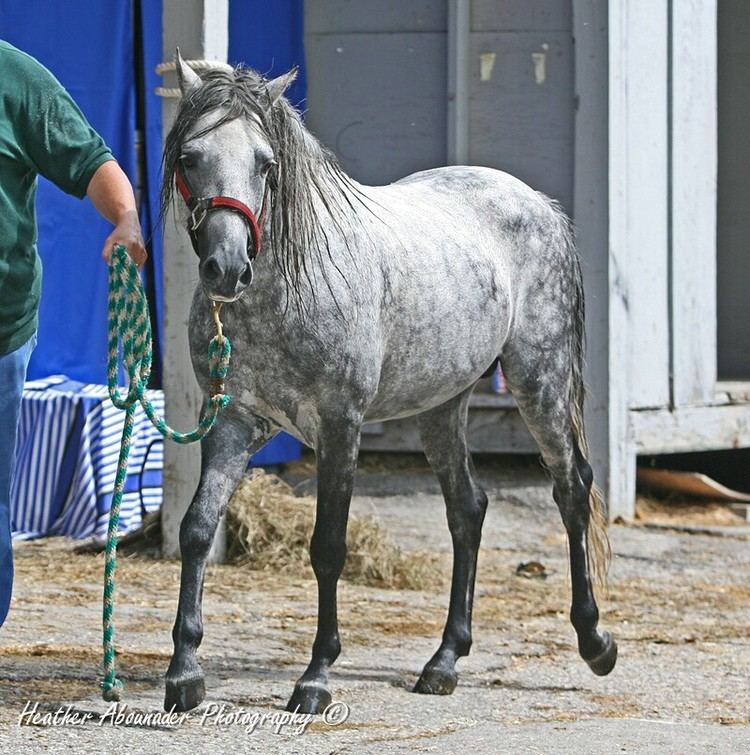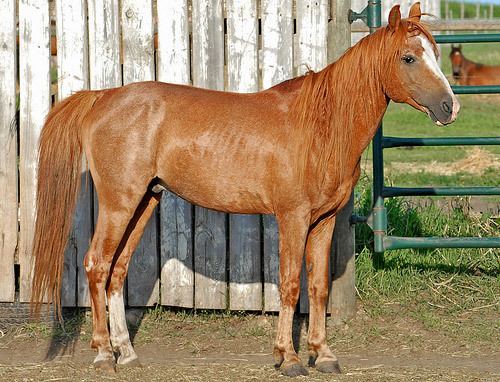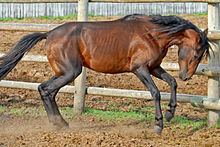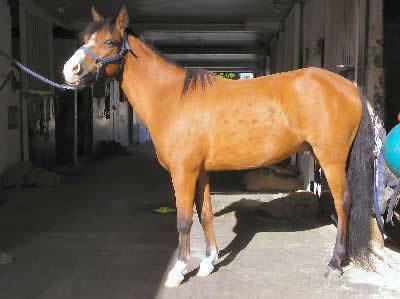Other names Caspian horse Higher classification Horse | Scientific name Equus ferus caballus Rank Breed | |
 | ||
Distinguishing features Small, ancient horse breed rediscovered in 1965; now bred in several other countries Similar | ||
The Caspian is a small horse breed native to Northern Iran. Although its original height probably ranged between 9 and 11.2 hands (36 and 46 inches, 91 and 117 cm) it is termed a horse rather than a pony because, size apart, it has much in common with horses in terms of conformation, gaits and character. It is believed to be one of the oldest horse or pony breeds in the world, descended from small Mesopotamian equines that, in competition with larger animals, had faded from attention by the 7th century AD. They were brought to public notice again when rediscovered in 1965 by Louise Firouz, an American-born breeder of Iranian horses living in Iran. In 2011, the remains of a horse dating back to 3400 B.C.E. were found at Gohar Tappeh, Iran, giving rise to claims that the Caspian is the oldest known breed of domestic horse that still exists. It is also called Khazar Horse, after one of Caspian sea's native names in Iran.
Contents
- Endangered extinct caspian horse breed
- Characteristics
- Genetics and phenotype
- Ancient history
- Rediscovery in 1965
- Louise Firouz
- IranIraq war
- Uses
- Part Bred Caspians
- References

Endangered extinct caspian horse breed
Characteristics

Caspian horses generally stand between 100 to 120 cm (39 to 47 in) tall, although better feeding conditions outside of Iran often result in taller specimens. They have a short, fine head with a pronounced forehead, large eyes and short ears. The muzzle is small and the nostrils large and low on the head. Overall the body is slim and graceful, with sloping shoulders, good withers and a high-set tail. The legs and hooves are strong. Caspians are described by Louise Firouz as kind, intelligent and willing. They are spirited but without meanness, and even stallions can be ridden by children. Their gaits are long, and they occasionally exhibit an ambling "single-foot" gait. Despite their small size, they are good jumpers. Although small, they are morphologically and phenotypically horse-like, and were originally referred to as "miniature horses". Now that the word "miniature" is more usually associated with genetically-constructed "toy" horses, the term is no longer used to describe the Caspian Horse.

The Caspian Horse is extremely hardy, with strong feet that rarely need shoeing unless consistently working on very hard or stony ground. Great length from hip to hock may be a factor in their incredible jumping ability. The usual colours are bay, grey, black, dun or chestnut. A few have white markings on the head and legs. Interestingly, some lack chestnuts or ergots.
Genetics and phenotype
Although there are no records of breeding prior to 1965, the foundation animals included in the International Caspian Stud Book were proven by Louise Firouz to breed true to type and their descendants have, for the most part, retained Caspian characteristics. They are therefore an established breed. Improved living conditions outside Iran have produced Caspians that have grown larger than their Iranian foundation parents; modern Caspians range between 10hh (102 cm) and occasionally 12.2 hh(127 cm), averaging 11.2 hh (117 cm).
Research has shown that Caspian and Turkoman horses occupy positions in phylogenetic analysis that has given rise to a hypothesis that they could be ancestral to all other oriental type breeds studied to date. However, close study of Caspian and other equid skeletons by Firouz and others found several anomalies unique to the Caspian:
Ancient history
A partial answer to the existence of the Caspian is the fact that the Persian Empire, which flourished in the first millennium B.C, has been called "the first great road empire". Before the Romans built their first road for marching men, the Persians constructed broad straight dirt roads, well maintained for speedy couriers and busy senior administrators. Herodotus wrote that:
"There is nothing in the world which travels faster than these Persian couriers. It is said that men and horses are stationed along the road…a man and a horse for each day. Nothing stops these couriers from covering their allotted stage in the quickest possible time, neither snow, rain, heat nor darkness."The oldest known specimen of a horse in the region now home to the Caspian horse was found in 2011, in a cemetery dating back to 3400 B.C.E., in the archaeological dig at Gohar Tappeh in the province of Mazandaran in northern Iran, between the cities of Neka and Behshahr. The horse was identified by its "form, figure, and size" as having a light frame, thin bones, short, fine head with a pronounced forehead, large eyes, short ears, and small muzzle.
The Persian Empire required land transport on a huge scale. They were the first people to breed horses especially for strength and speed. That these horses were very small by modern standards is shown by a miniature golden chariot, a toy or perhaps a votive offering, found in the so-called Oxus Treasure, discovered in the extreme east of the empire but apparently made in central Persia. The vehicle was obviously built for speed. Its wheels are higher than the horses, which are themselves of lesser height than the two passengers - and not because of the status of the passengers. Neil MacGregor likens this vehicle to a Ferrari or Porsche amongst cars – fast and luxurious. King Darius (the Great) trusted his life to the little horses during lion hunts, and honoured them on his famous Trilingual Seal.
As seen on the bas reliefs on the great staircase at Persepolis the Persian Shah demanded tributes of only first class animals. Those depicted were probably from Lydia in Turkey, judging by the grooms' appearance, and the horses are of similar size to the four in the Oxus Treasure. Skeletons with the same bone structure as the Caspian were found at Hamadan.
Yet the fine little horses so valued by the Persian Empire virtually disappeared from history after libraries and monuments were destroyed in the great Mongol and Islamic conquests. Almost no further mention was found of them after 700 AD and until 1965, modern scholars believed that they had become extinct.
It is now assumed that the modern Caspian descended from the great pool of quality stock that once formed the essential foundation of the Persian Empire. Caspians, known locally as moulek or pouseki ponies ("little muzzle"), now inhabit an area in the north of Iran between the Caspian Sea and the Elburz Mountains. Horses potentially related to the Caspian have also been identified in a much wider range, as history might lead us to expect.
Rediscovery in 1965
The specimens discovered since 1965 originated mainly from peasant-owned stock and were not bred selectively, so it may seem remarkable that animals of such quality have survived in a relatively unaltered form. In addition, peasants in the Alborz Mountains habitually turn their stock out on the hills in semi-feral conditions, where they are vulnerable to attack by predators. Natural selection would probably have favoured an animal that was tough and athletic, but there is evidence to suggest that their small size may be due to recessive genes. Peasants have said that occasionally a larger mare and stallion will produce such a foal.
Louise Firouz
At first thought to be a pony, the Caspian Horse was re-discovered in 1965 in this mountainous region of northern Iran by the American-born breeder of Iranian horses, Louise Firouz, while searching for small ponies to be ridden by children. She saw a small bay stallion in the town of Amol pulling a clumsy cart, but with the body of a "well-bred oriental horse." She purchased the stallion, naming him Ostad (and later nicknaming him 'The Professor' due to his 'wise' nature). Following her discovery, Firouz concluded:
" ….. there was an elusive beauty and grace about this small horse which did not seem to fit into the accepted picture of ponies. Ponies are chunky, strong little equids generally developed under austere conditions of climate and food. Why a "pony" on the relatively lush shores of the temperate Caspian: and, in spite of his small size, was the light, graceful animal on the Caspian a pony at all? Was there any historical precedent for a pony-sized horse in Iran and, if so, how well documented was it? These questions initiated a study in the spring of 1965 to determine the range, nature and historical precedent for a horse of this size in Iran."With seven mares and six stallions, Firouz began a breeding program at her riding school in Norouzabad, with the horses she named "Caspian" from the area where she had found them. The horses themselves were much enjoyed by the children; Ostad became a successful sire of children's ponies and was ridden daily in the company of mares. Firouz started the Iranian stud book in 1966. In 1973 the stud was sold to the Shah of Iran, who established the Royal Horse Society at the Norouzabad Stud.
In late 1965, while visiting her family in Great Falls, Virginia, Firouz told Kathleen McCormick the Caspian story and showed photographs of the ponies she had brought to Norouzabad. They decided to export a Caspian stallion from Iran to the United States and McCormick selected the foundation stallion Jehan from the photographs. In April 1966, William M. Santoro, DVM, accompanied Jehan on the four-day, 8,000-mile journey to New York. Due to the difficulties experienced in exporting Jehan from Iran, only a part-bred breeding program was established in the US at that time and plans to import mares were put on hold. In 1975 a further stallion was exported to Venezuela from Iran.
Meanwhile, a new herd of twenty mares and three stallions established on the Turkoman Steppes by Firouz, suffered repeated and fatal wolf attacks. This forced the emergency evacuation of six mares and a stallion to the Caspian Stud UK in 1976 and the remainder were taken over by the Royal Horse Society of Iran. They were later widely dispersed during the Iranian Revolution, leaving only one traceable stallion. The subsequent ban on keeping horses ended the breeding programme in Iran until 1986, when Firouz found and purchased three mares and a stallion.
Iran/Iraq war
During the Iran/Iraq war, most horses were swept up to aid the war effort, but in 1989, Firouz was invited to inspect the remaining horses for possible Caspian breeding stock, resulting in six more potential foundation animals. These horses founded her "Persicus" stud. In 1994, seven of her Caspians were exported for breeding in England and in 1995 several Caspians from the UK, Australia and New Zealand were shipped to the USA. After her husband's death, Firouz sold the Persicus stud to the Iranian Ministry of Agriculture, which has continued her breeding and research programmes in Iran. Louise Firouz died in May 2008
Although the Caspian must still be considered rare, the combined efforts of breeders across the world have established the breed in Scandinavia and other parts of Europe, and in Australia, New Zealand, and the United States. Breed Societies are affiliated to the International Caspian Stud Book.
Uses
The horses are mainly used in the towns of Amol, Babol, Shahi and Rasht in Northern Iran, as cart ponies, They are valued for their speed and ability to pull or carry heavy loads in the narrow streets and bazaars. During the late 1960s, Caspian stallions from the Norouzabad riding school were raced on the prestigious Tehran racetrack by small children wearing jockey silks, by courtesy of the late Shah of Iran, Mohammad Reza Pahlavi.
Caspians are known for their good temperaments and "horse-like" personalities. As noted by Firouz, stallions are frequently handled by children and, like Firouz, some owners turn several out together for exercise and companionship in the absence of mares.
With their comfortably narrow conformation, Caspians make excellent children's mounts. Their long, level paces, natural grace and balance make them very suitable for dressage. Sensible but active, they can be impressive in mounted games, gymkhana and pony racing.
In harness they make a smart, responsive light driving pony and have successfully competed in national scurry and cross-country obstacle driving. Their extraordinary jumping ability makes them highly competitive for show jumping and eventing.
Part-Bred Caspians
Crossbred with larger breeds, including Thoroughbreds and Arabians, they produce fine show ponies, show jumpers and eventers for the taller child. Another popular cross is with the Welsh Pony. Having been noted that the appearance, characteristics and athletic abilities of Caspians are passed in good measure to part-bred offspring, the Caspian Horse is being included in breeding programmes to produce the ideal Sports Pony. There are stud books in most recognised Caspian societies for part-bred Caspians.
